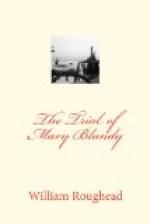[Illustration: Facsimile of the Intercepted Letter to Cranstoun written by Mary Blandy (From the original MS. in the Public Record Office.)]
Meanwhile Dr. Addington had applied to the mysterious powder the tests prescribed by the scientific knowledge of the time, which, if less delicate and reliable than the processes of Reinsch and Marsh—a red-hot poker was the principal agent—yielded results then deemed sufficiently conclusive. Judged by these experiments, Mrs. Morgan’s mystic philtre was composed of nothing more recondite than white arsenic. When Dr. Addington called on Monday he found the patient much worse, and sent for Dr. Lewis, of Oxford, as he “apprehended Mr. Blandy to be in the utmost danger, and that this affair might come before a Court of judicature.” He asked the dying man whether he himself knew if he had “taken poison often.” Mr. Blandy said he believed he had, and in reply to the further question, whom he suspected to be the giver of the poison? “the tears stood in his eyes, yet he forced a smile, and said, ’A poor love-sick girl—I forgive her. I always thought there was mischief in those cursed Scotch pebbles.’” Dr. Lewis came, and confirmed Dr. Addington’s diagnosis; by their orders Mary was that evening confined to her chamber, a guard was placed over her, and her keys, papers, “and all instruments wherewith she could hurt either herself or any other person” were taken from her. Dr. Addington graphically describes the scene when the guilty woman realised that all was lost. She protested that from the first she had been basely deceived by Cranstoun, that she had never put powder in anything her father swallowed, excepting




